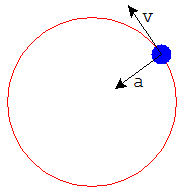Question #6fab5
1 Answer
The answer is (b) KE remains constant.
Explanation:
For a moving object, a uniform circular motion implies that the object in question is moving along a circular path at constant speed.
Uniform circular motion is actually a great example to cite when talking about the difference between speed and velocity.
Although the speed of an object that has a uniform circular motion is constant, its velocity is not constant. Not only that, but it is actually changing constantly.
Velocity is actually a vector quantity, which implies that it is decribed by magnitude and direction. The magnitude of the velocity vector is the speed of the object.
In the case of a uniform circular motion, the direction of the moving object is always tangent to the circular path, which is why velocity changes despite the fact that speed is constant.

The consequence of this change in velocity is that the object will also develop an acceleration oriented towards the center of the circular path.
This acceleration is called centripetal acceleration and depends on the speed of the object and on the radius of the circle
At constant speed, the magnitude of the centripetal acceleration is constant. However, since this is a vector quantity, the fact that its direction changes constantly implies that the acceleration vector is not constant.
So, if you take all this into account, the only option available remains option (b). If speed is constant, kinetic energy is also constant.
This is true regardless if the motion takes place on a horizontal or on a vertical plane. As long as speed is consstant, kinetic energy is constant.

